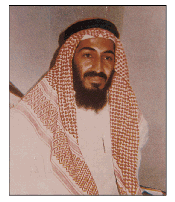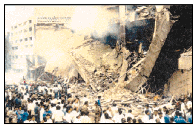U.S. DEPARTMENT OF STATE
1997 APRIL: PATTERNS OF GLOBAL TERRORISM, 1996
Office of the Secretary
Office of the Coordinator for Counterterrorism, Philip C. Wilcox, Jr.
![[Next]](next.gif)
![[Previous]](previous.gif)
![[Index]](index.gif)
ASIA OVERVIEW
CONTENTS
Although terrorism remains a concern in East Asia, national reconciliation
efforts in Cambodia and the Philippines, and successful prosecutions
in Japan, have helped reduce the terrorist profile in the region.
Continuing defections by Khmer Rouge troops in Cambodia have reduced
their numbers considerably, although the Khmer Rouge is still
considered active and dangerous. Talks between the Philippine
Government and a major insurgent group there have resulted in
a peace agreement, although another major insurgent group has
continued attacks in the southern Philippines, and terrorist groups
continue to plague that nation. In February the Philippines hosted
an international conference on counterterrorism at Baguio, which
was attended by representatives of 20 nations, including the United
States. The prosecution of a series of leaders of the Aum Shinrikyo
cult in Japan, based primarily on the 1995 sarin nerve gas attack
in the Tokyo subway, and the continued pursuit of Aum leaders
still at large have dealt a heavy blow to that group. Terrorist
activities by the Free Papua Movement (OPM) in Indonesia and by
insurgent groups in a number of East Asian countries continue
to pose a threat.
In South Asia, terrorist training camps located in Afghanistan
remain open. The fate of the four Western hostages, who were kidnapped
in July 1995 by Kashmiri militants believed to be associated with
the Pakistan-based Harakat ul-Ansar (HUA), remains unknown. Reports
from Kashmiri militant sources maintain that the hostages were
killed in December 1995, although these reports have not been
confirmed.
In Sri Lanka, the Liberation Tigers of Tamil Eelam (LTTE) continued
to carry out extremely violent attacks in its ongoing campaign
to cripple the economy and target government officials. A truck
bomb destroyed the Central Bank, killing some 90 persons and wounding
hundreds more. A commuter train was bombed, and a bus was ambushed,
killing more than 80. The LTTE continued to assassinate political
opponents, both civilian and military.
The Indian and Pakistani Governments each claim that the intelligence
service of the other country sponsors bombings on its territory.
Plagued by the absence of a cohesive central government and ongoing
fighting among rival factions, Afghanistan remained a training
ground for Islamic militants and terrorists in 1996. Ahmed Shah
Masood, Gulbuddin Hekmatyar, and Abdul Rasul Sayyaf all maintained
training and indoctrination facilities in Afghanistan, mainly
for non-Afghans. They continue to provide logistic support and
training facilities to Islamic extremists despite military losses
in the past year. Individuals who trained in these camps were
involved in insurgencies in Bosnia and Herzegovina, Chechnya,
Tajikistan, Kashmir, the Philippines, and the Middle East in 1996.

Usama Bin Ladin
The Taliban militia, which took over the capital city, Kabul,
in September, has permitted Islamic extremists to continue to
train in territories under its control even though they claimed
to have closed the camps. The group confiscated camps belonging
to rival factions and turned them over to groups such as the Pakistan-based
Kashmiri terrorist group Harakat ul-Ansar.
Saudi-born extremist Usama Bin Ladin relocated to Afghanistan
from Sudan in mid-1996 in an area controlled by the Taliban and
remained there through the end of the year, establishing a new
base of operations. In August, and again in November, Bin Ladin
announced his intention to stage terrorist and guerrilla attacks
against US personnel in Saudi Arabia in order to force the United
States to leave the region.
Continuing defections throughout 1996 have greatly reduced the
number of Khmer Rouge guerrillas. Defectors are in the process
of being integrated into the Royal Cambodian Armed Forces. Nevertheless,
Khmer Rouge hardliners conducted numerous violent attacks, primarily
against Cambodian military forces, and were also responsible for
the killings, kidnapping, and abduction for forced labor of civilians.
In March the Khmer Rouge kidnapped a British citizen who was involved
in clearing mines. Rumors of his death have been denied by Khmer
Rouge spokesmen. There has been occasional Khmer Rouge rhetoric
suggesting that Westerners especially are being targeted for terrorist
acts, but a terrorist campaign specifically directed at Westerners
has not developed.
India continues to face security problems because of the insurgency
in Kashmir and separatist movements elsewhere in the country.
Numerous small bombings and assassination attempts against local
politicians occurred throughout the year, but particularly during
the fall, when the first legislative assembly elections since
1987 were held in Kashmir and the newly elected state government
was installed. A militant group based in Pakistan calling itself
the Jammu and Kashmir Islamic Front (JKIF) claimed responsibility
for car bombings in New Delhi in January and May and a bus bombing
in Rajasthan in May that killed at least 40 people. Kashmiri militants,
believed to be associated with the Pakistan-based Harakat ul-Ansar
(HUA), may have killed the four remaining Westerners-one US citizen,
two Britons, and one German-whom they captured in July 1995 hiking
near Srinagar, Kashmir, although their deaths have not been confirmed.
Another US citizen managed to escape, but a Norwegian hostage
was killed in 1995.
The Government of India has been largely successful in controlling
the Sikh separatist movement in Punjab State, but Sikh groups
claimed to have worked with the Kashmiri JKIF to bomb targets
in New Delhi.
Other insurgent groups in the northeastern state of Assam and
the southern state of Andhra Pradesh attacked security officials,
rival political leaders, civilians, and infrastructure targets
throughout 1996. Insurgents in Assam damaged oil pipelines for
the first time in November. In Andhra Pradesh, the Naxalite People's
War Group staged several attacks on police and local political
leaders from September through November after a previous ban on
the group was reimposed.
The Indian and Pakistani Governments each claim that the intelligence
service of the other country sponsors bombings on its territory.
There were reports that official Pakistani support to militants
fighting in Kashmir, including the HUA, continued well into 1996.
Pakistan alleged in a detailed press report that India sponsored
a series of bombings in Pakistan's Punjab Province from late 1995
to mid-1996 in which at least 18 civilians were killed.
The prosecution of Aum Shinrikyo leader Shoko Asahara and other
cult leaders continued in 1996. Several additional Aum Shinrikyo
members who had been implicated in the 1995 sarin nerve gas attack
in the Tokyo subway that killed 12 persons were arrested in Japan
in 1996.
Five former cult officials have testified in court that Asahara
instructed them to carry out the subway gas attack and other killings.
In addition to the murder charge stemming from the gas attack,
Asahara faces 16 other charges ranging from kidnapping and murder
to illegal production of drugs and weapons.
Although no longer active in Japan as a terrorist group, Japanese
Red Army members remain at large elsewhere around the world.
Terrorist-related violence continues in Pakistan as a result of
domestic conflicts. Sectarian violence, including bombings, continued
throughout the year in Sindh, Punjab, and in the North-West Frontier
Provinces, resulting in about 175 deaths. Although the government
has quelled much of the violence in Karachi, it has yet to produce
a political settlement that would provide a lasting peace. The
Pakistani Government has attributed most terrorist acts in Karachi
either to the ethnically-based Mohajir Quami Movement (MQM) or
to the Shaheed Bhutto group of the Pakistan People's Party, which
was led by former Prime Minister Benazir Bhutto's brother until
his death in a clash with police on 20 September.
The Government of Pakistan acknowledges that it continues to provide
moral, political, and diplomatic support to Kashmiri militants
but denies allegations of other assistance. Reports continued
in 1996, however, of official Pakistani support to militants fighting
in Kashmir. One Pakistan-backed group, the Jammu and Kashmir Islamic
Front (JKIF), claimed responsibility for three bombings in and
near New Delhi in early 1996 that killed at least 40 persons.
There also are reports that militants associated with the Harakat
ul-Ansar (HUA) may have killed four Westerners kidnapped in Kashmir
in July 1995.
Pakistan alleged in a detailed report in the press that India
had sponsored a series of bombings in Pakistan's Punjab Province
from late 1995 to mid-1996, in which at least 18 persons were
killed. In July authorities arrested a Pakistani national who
claimed that Indian intelligence agents recruited him and provided
him with explosives for the bombings. In mid-November a court
in Lahore sentenced one individual to death and another to life
imprisonment for their involvement in the bombings.
The Philippine Government scored a major triumph when it concluded
a peace agreement with the Moro National Liberation Front, the
largest Muslim rebel group, ending its 24-year insurgency. Negotiations
with the second-largest insurgent group, the Moro Islamic Liberation
Front (MILF), proceeded slowly, however, and clashes continued
between MILF and government forces in the southern Philippines.
The MILF and the smaller, extremist Abu Sayyaf Group are both
fighting for a separate Islamic state in the southern Philippines.
Earlier in the year, a wave of bombings in Mindanao was attributed
to Muslim extremists; several of the attacks targeted Christian
churches. For the most part, these attacks have been limited to
the southern Philippines, but in February a grenade attack in
the Makati business district of Manila wounded four persons and
damaged the local headquarters of both Shell and Citibank. Police
suspect the Abu Sayyaf Group. Other terrorist groups in the Philippines
include the Alex Boncayao Brigade, which claimed responsibility
for the assassination of a former provincial vice governor in
June 1996, and the New People's Army. These three groups were
believed to have been planning attacks during the APEC conference,
held in Manila in November; a bomb was discovered and defused
at Ninoy Aquino International Airport that week. No group claimed
responsibility, and no arrests were made.
The successful prosecution in the United States of Ramzi Ahmed
Yousef on charges of plotting to bomb US passenger jets in Asia
and the Pacific was due largely to outstanding cooperation from
the Philippine Government. At the same time, persons convicted
of terrorist acts in the Philippines are among those eligible
to apply for amnesty under a national reconciliation program set
up for former rebels who committed crimes in pursuit of political
objectives.
In February the Philippines hosted the Baguio Conference, an international
conference on counterterrorism. The 20 nations represented there,
including the United States, issued a communique expressing their
collective commitment to combat terrorism in several important
ways.
The separatist group Liberation Tigers of Tamil Eelam (LTTE) continued
its campaign of violence in 1996, attacking economic and infrastructure
targets and assassinating political opponents. The LTTE exploded
a truck bomb near the Central Bank in Colombo on 31 January, killing
some 90 persons; bombed a commuter train on 24 July, killing 70;
and ambushed a bus in September, killing 11 civilians. The group
staged a suicide bomb attack on the Minister of Housing in Jaffna
in July. Although the minister survived, 25 persons were killed,
including a Brigadier General.
The LTTE has refrained from targeting Western tourists, but a
front group-the Ellalan Force-continued to send threatening letters
to Western missions and the press.

Damage from truck bomb exploded by LTTE in Colombo, 31 January.
(Copyrighted Daily News)
![[Next]](next.gif)
![[Previous]](previous.gif)
![[Index]](index.gif)
|

